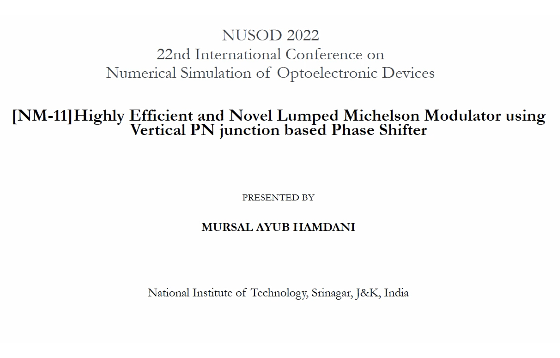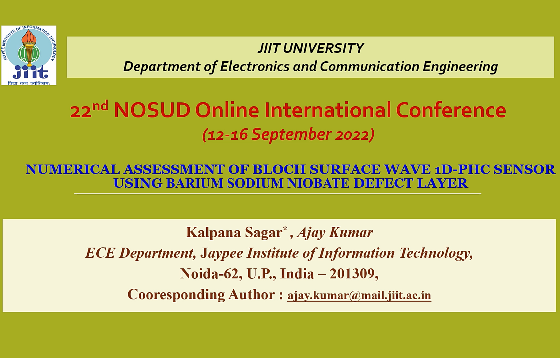Poster61 Videos



An 120° hybrid for bimodal interferometers in the 220 nm silicon-on-insulator technology is presented. Three output signals enable an unambiguous phase detection over a 360°-range as well as a constant sensitivity. The length of the hybrid is only 190 µm with a simulated excess loss of 0.16 dB. Measurements combined with digital signal processing verify […]
P18 – The counter-propagating traveling-wave technique for optimizing a continuous-wave fiber laser presenting excited state absorption
We report results of simulation of a continuous-wave fiber laser with active medium presenting an excited state absorption. The laser was simulated using the counterpropagating traveling-wave technique with taking into account two laser waves propagating along the laser cavity in opposite directions, two waves of amplified spontaneous emission, and exited state absorption observed for both […]
NM15-Performance Optimization of Surface Plasmon Resonance based Sensors from the First Principle
Performance optimization of surface plasmon resonance (SPR) based sensors due to improvement in input optical coupling is theoretically investigated from the first principle. Various design parameters are optimized in a typical prism coupling Kretschmann configuration.
NM07 – Early Cancer Detection by Plasmonic PCF Sensor
Great research work has been studied for cancer detection due to its high death rate. In this paper, a novel design of photonic crystal fiber (PCF) biosensor based on surface plasmon resonance (SPR) is introduced and numerically analyzed for cancer cell detection. Full vectorial finite element method (FVFEM) is used throughout the numerical analysis of […]
IS13 – Design and Performance Analysis of All Optical Half Adder based on Carrier Reservoir SOA -Mach Zehnder Interferometer (MZI) Configuration
In this manuscript, Carrier reservoir SOA (CR-SOA) based half adder is proposed and simulated at 100 Gb/s. CR-SOA has fast carrier recovery, due to presence carrier reservoir which enables its use at higher data rates on the other hand conventional SOA suffers from slow carrier recovery which leads to unequal amplification of pulses. The obtained […]
P13 – Genetic algorithm optimization of infrared plasmonic absorbers
The absorption of a multiband absorber based on a periodical plasmonic grating has been optimized. The optical and geometrical parameters of the plasmonic structure which is composed of germanium and gold are determined by an efficient genetic algorithm. The electromagnetic response of the absorber is numerically obtained by using the frequency domain finite element method. […]
LD13 – Numerical Analysis of Electrically Pumped SiGeSn/GeSn Quantum Well Transistor Laser
The threshold current density of electrically pumped Sn incorporated group IV alloy based transistor laser (TL) is analyzed by proposing and designing a theoretical model for the same. Active region for the lasing action is formed by strain compensated GeSn single quantum well (QW) in the base of the transistor. The threshold current density for […]
P07 – Low-Cross-Talk Metal-Dielectric-Metal Waveguide Intersections Based on Sodium
We analyzed the transmission properties of two plasmonic waveguides crossing by using numerical simulations. The subwavelength width waveguides are composed of sodiumair-sodium. The crossing structure is composed by a compact cross-shaped resonant cavity with a four-fold symmetry. The results demonstrated the feasibility of using sodium as a low loss material for several applications for nanoplasmonic […]
IS11 – Numerical Investigation of the Performance of OAM-Mode Shifting Recirculating Delay Loop Under the Effect of Mode Shifter Displacement
We investigate the effect of OAM mode shifter displacement on the performance of the OAM-mode shifting recirculating delay loop by simulating the beam propagation using Kirchhoff-Fresnel diffraction. Simulation results indicate that 20 delayed replicas may be obtained with >10 dB signal-to-crosstalk ratio (SCR) if alignment is perfect and ℓshift=+1
NM12 – Design of Slot Waveguide based Directional Coupler for Optical Sensing of low concentration of Ethanol in Water
In this study, sensing of low concentration (0-10%) of ethanol in water is presented by refractive index sensing by silicon slot waveguide-based direction coupler. The significance spectral variation and sensitivity is observed to detect low concentration of ethanol in water.
NM11 – Highly Efficient and Novel Lumped Michelson Modulator using Vertical PN junction based Phase Shifter
Vertical PN depletion phase shifter based novel Common Mirror Michelson Modulator is proposed. It has a lower V, higher ER for a particular value of source impedance at a given bitrate and doping than conventional PN phase shifter based modulator.
P23 – Nanoplasmonic Ultra Compact, Low Insertion Loss UWB Band-Pass Filter Using Square Ring Resonators
This article presents the design and analysis of a nanoplasmonic ultra wide band (UWB) band-pass filter based on metal insulator metal (MIM) slot-waveguide using three square ring resonators (SRRs) for obtaining ultra wide band nature at optical frequencies. This filter shows the low insertion loss due to the zero coupling gaps and no mismatch between […]
P15 – Numerical simulation of silicon grating-based plasmonic sensor
This work reports on the application of silicon grating-enabled nanostructure for refractive index sensing application in the near-infrared region. This grating helps in launching the plasmon modes efficiently towards the flat metal film deposited with a thin Al2O3 layer. The normal incidence light is used which can be helpful for its integration with optical fiber. […]
N08 – Inverse Design of Multilayer Thin film by Deep Neural Network
Inverse Design of TiO2 − SiO2 based multilayer thin film for normal incidence of TM polarized light in visible region by Deep Neural Network is reported. The simulated and the target transmission spectra are closely following.
MM11 – The Variations of Photoluminscence Decay Times Under The Influence of A Trapping State
We numerically calculated the time-resolved photoluminescence spectra using the bimolecular trapping-detrapping model. The variations of carrier lifetimes are investigated by changing the carrier recombination and trapping rate constants, as well as the concentration of available trapping states.
P19 – Numerical Assessment of Bloch Surface Wave 1D-PhC Sensor using Ba2NaNb5O15 Defect Layer
In this paper, a top defective layer of Barium sodium niobate (Ba2NaNb5O15) material of nanometer range thickness is used to confine Bloch surface mode at the upper interface of the proposed structure. For a 1275 nm operating wavelength, the structural characteristics are intended to stimulate a BSW at the top interface. Wavelength interrogation, angle interrogation, […]
NM09 – Calculation of intersubband absorption in n-doped BaSnO3 quantum wells
In this work we explore novel and promising BaO/BaSnO3 perovskite-oxide quantum well material system which has recently attracted attention due to its many advantages and possible applications in electronic devices. We focus on calculation of intersubband absorption in La-doped BaSnO3 quantum wells and investigate the tuning of absorption spectra with QW thickness and external electric […]
P21 – Numerical investigation of optical bistability in inhomogeneous PT -symmetric gratings
Customizing the nonlinear profile along the direction of propagation helps in the realization of low-power all-optical switches. The switching intensities are extremely low (<0.01) in the broken regime provided that the light launching direction is right. It is believed that the switching intensities in the broken regime are always higher than that of the unbroken […]
D09 – Analysis of Differential Phase Shift Quantum Key Distribution using single-photon detectors
We investigated the performance of differential phase shift quantum key distribution using InGaAs/InP and Silicon-APD (avalanche photo diode) for generating secure keys, secure communication distance, and bit error rates under the various operating conditions.We compare the quantum bit error rate and the secure key generation rate as a function of communication length.Our simulation results show […]
D07 – Theoretical study of back-to-back avalanche photodiodes for mid- and longwave infrared applications
The dual-band N+-p-p-p-P+-p-p-p-n+ avalanche photodiode (APDs) structure is designed and numerically analyzed in detail. We conducted a theoretical study of APD for medium wave (MWIR) and longwave infrared (LWIR) applications. The current-voltage (I-V) characteristics for the bias range -6V
LED09 – Enhanced optoelectronic properties of UV-C light-emitting diode
We numerically analyzed proposed structure named as LED S2 in comparison to reference structure LED S1. In LED S2 we introduced undoped AlGaN and p-AlGaN layers between the electron blocking layer (EBL) and the p-GaN (hole injecting layer). The simulation finding shows proposed structure (LED S2) provide a better strategy for lowering electron overflow and […]
N09 – Beam shaping using a chain of photonic nanojet induced plasmonics
Photonic nanojet arises from a microcavity leading to high electric field. On the other hand, metal nanoparticles (NPs) lead to high field due to localization in small volumes. In this work, PNJ from an array of cavity induced plasmon resonances has been studied. The sharp profile of the PNJ has been observed by the inclusion […]
LED03 – RGB LED active region design and optimization with Genetic Evolution Algorithm
Multi-quantum-well (MQW) LED is a complex distributed system with strong interaction between two opposite carrier flows, electrons and holes. For both types of carriers, the carrier injection into each QW depends on transport conditions across the whole active region (AR) and is affected by capture-recombination balance in all active QWs. Multi-color LEDs with different types […]
P17 – Simulation Analysis of Microring Resonator in Mobius Topology
In this paper, a microring resonator in Mobius topology is modelled and simulation analysis is carried out. The free spectral range of this silicon-on-insulator based photonic device is found to be 23.4 nm. This structure of microring resonator finds place in various applications such as sensors, polarization analysis, wavelength-selective reflectors.
P20 – Simulation of Optical Planar Waveguide Sensor for Microplastics Detection in Water
Nowadays, microplastics pollution has become a global concern as it endangers the ecology, marine animals, and cause health threats to human beings. This paper attempted to simulate an optical planar waveguide sensor for microplastics detection in water via Wave Optics Module-COMSOL Multiphysics®. The analyte refractive index was ranged from 1.4800 to 1.5000 RIU, in reference […]
D06 – Examination of Resonant Cavity Enhanced Strain Compensated SiGeSn/GeSn Interband MQWIP
In this work, mathematical investigation is done for the potential of Group IV alloy based resonant cavity enhanced interband multiple quantum well photodetector (MQWIP). Strain balanced multiple quantum well structure is proposed to be configured between two Bragg reflectors (mirrors) to form a resonant cavity. Responsivity is calculated by solving the rate equation in each […]
IS14 – Tunable optical mode converter based on SOI asymmetric channel waveguides
An optical mode converter based on asymmetric dual channel waveguides is reported and analyzed. The first channel is infiltrated with nematic liquid crystal (NLC) material while the second one has BK7 glass core. The first higher order mode of the NLC core is coupled to the fundamental mode of the neighboring core with high coupling […]
SC04 – Performance Evaluation of Lead-Free Cs2CuSbCl6 Perovskite Solar Cells for > 21.67% Efficiency
This work investigates the performance of Cs2CuSbCl6-based lead-free perovskite solar cells for photovoltaic applications. Cs2CuSbCl6 has a bandgap of 1.7eV and it is a durable and non-toxic material. Cs2CuSbCl6 can absorb more photons and thus obtain high efficiency. This work has been performed using SCAPS-1D software with the focus on optimizing the absorber layer thickness […]
LED07 – Effect of Parabolic Quantum Well on Internal Quantum Efficiency of InGaN/GaN based MicroLED at low current density
The quantum cascade stark effect (QCSE) in rectangular shaped quantum well (QW) poses a hindrance to increase the internal quantum efficiency (IQE) of nitride based LEDs. To circumvent the said problem for micro-LEDs operating at low current density, a parabolic QW structure has been proposed which is found to be useful to alleviate the QCSE […]
P08 – Tunable Guided-mode resonance filter using Spacetime Periodic Structure
We present a tunable planar guided-mode resonance (GMR) filter using time-varying permittivity along grating nanobars. Results show that the effective medium concept in the temporal state is exactly the same as the spatial state. Furthermore, the structure has spatial periodicity to save the resonance peak of the passive GMR in addition to the temporal periodicity […]































